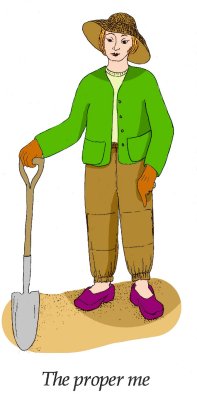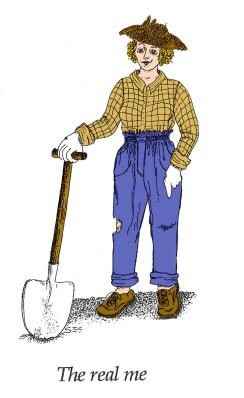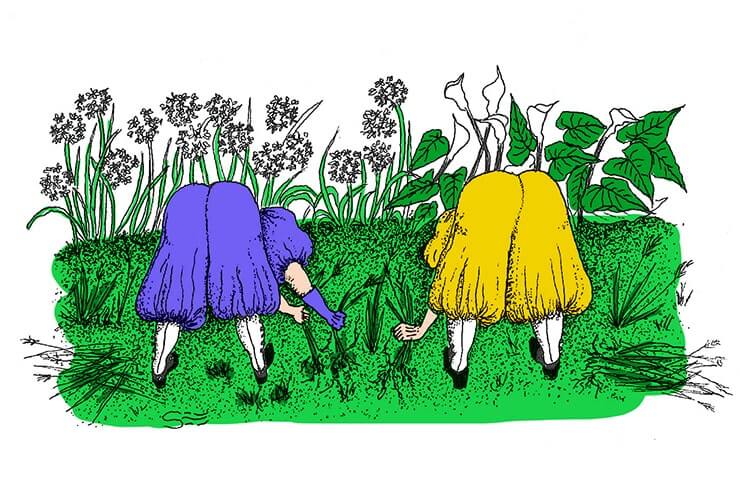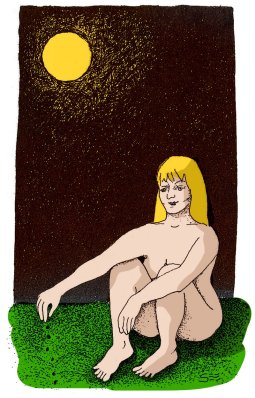Read by Matilda Longbottom

The catalogues are spread around, and we are planning the garden. This year there isn’t much space for new plants, and last year I didn’t sow all the seeds I’d ordered. I’m looking at the catalogues anyway (it’s too cold to go outside), and now I see that for all these years I’ve been engrossed with plants or seeds and even, occasionally, new tools and not ever thought about how the garden looks with me in it: It seems I haven’t been properly dressed. According to my catalogues, things would look a lot better if I dressed properly for the job.
There is a “gardener’s hat” in various styles, all offering excellent protection from that nasty ozone hole we hear so much about. If you haven’t a hole in your hat, the hole in the ozone won’t hurt you. I do, so I probably need a new hat.
Then it seems that my son’s old pants really won’t do:
I need “gardener’s pants.” These have pockets in the knees into which you can insert Protective Foam knee Pads (sold separately). I can even get “Japanese Farmers’ Pants” —these, presumably, would be the kind of thing that Japanese Farmers’ mothers might wear when their sons had outgrown them—but of course I am not a Japanese Farmer’s mother but an ordinary old U.S. mother in ratty old pants, so I may need a pair.
I notice, too, that there is an offer of ladies‘ gardening gloves (guaranteed to fit feminine hands). This makes me wonder if the “Japanese Farmers” are not men but women, and if so, could I, a large American, hope to look like one of those gorgeous women whom one sees pictured in rice fields in National Geographic? Not encouraged, I think about feet.

Clogs: I can have them in yellow or red or green, or blue. I can either coordinate or contrast socks of the same colors. They don’t say what to do if I want contrasting feet. Maybe find a U.S. (woman) Farmer who’s interested in the same look, and we’ll buy two pairs between us and share them? My mother always said I tried to be difficult. She tried to get me to dress smartly like my sister.
Special clothes for gardening are not a new idea. In 1772, John Hill wrote in Virtues of British Herbs that “I was introduced in Yorkshire to one Brewer who has contrived a Dress on Purpose for Herbalising, and had a mask for his face and pads to his knees that he might creep into thickets.”
We are not told if the pads were inserted separately. Not all gardening clothes were designed to increase comfort, especially if they were imposed on gardeners by their employers.
In Aikenfield, a gardener says that, “We wore green baize aprons and collars and ties, no matter how hot it was.
The famous Miss Willmott of Warley Place made her gardeners wear a uniform of straw boaters with green ribbons, navy aprons, and knotted green silk ties.
Most Victorian gardeners wore bowler hats, but the Head Gardeners wore a full suit and top hat —presumably, he didn’t do the kind of work that would dislodge it.
An 1820s’ manual for servants said that the gardener should wear an apron, which, when he is pruning, he ties up before him and then serves to hold his nails, shreds, scissors, hammer and pruning knives.
Women gardeners, until recent times, have, of course, been hampered by skirts. Some women managed anyway. Gilbert White, writing about his “weeding woman,” said that “excepting she wears petticoats and now and then has a child, you’d think her a man.”
Weeding women were paid a fraction of what men gardeners earned and most weeding was done by women.
One good article of clothing they wore (which I have not seen in contemporary catalogues) was described by John Loudon in 1832 when he visited Aubrey Hall and saw weeding women wearing gloves with sharp wedge-shaped thimbles attached to forefinger and thumb.
On the whole, though, women, especially Victorian women, were not dressed for gardening. Louisa Johnson in 1837 wrote that “Every lady should be furnished with a gardening apron, composed of stout Holland with ample pockets to contain her pruning knife, a small stout hammer, a ball of string, a few nails and snippets of cloth. Have nothing to do with scissors.”
But a truer picture is seen in the Victorian Farmers’ Advocate, which instructs women that “If the walks are narrow, a little care will avoid sweeping one’s skirts over the beds to the injury of the flowers.”
By 1885, a daring writer, Daisy Eyebright, wrote that “a woolen bathing dress makes an excellent garden costume—for skirts are always in the way.” But few women would have been so daring, and poor Elizabeth, in Elizabeth and her German Garden, describes sneaking out when everyone was at lunch to dig a little and then scurrying back to sit like a lady in a chair.
Some women, even Victorian women, didn’t care. Marianne North, who travelled, botanized, and painted all over the world, arrived to visit the Ranee (Princess), Margaret of Sarawek, with a “diminutive portmanteau” of clothes and two “enormous cases” of painting gear. “With her topee, her very short petticoats, her light woolen jacket and high Wellington boots she was ready for any emergency.”
The famous Miss Jekyll did not care, either, if she showed her ankles (very improper at the time) and wore atrocious boots that have been immortalized for all gardeners by Sir William Nicholson who painted them and said, “I would rather paint Gertrude Jekyll’s boots than the most beautiful woman alive.”
Vita Sackville West wore breeches but we are told, she had always wanted to be a boy and often dressed like one even when not gardening. It’s hard for me, in my son’s trousers, to picture what it must have been like. When women gardeners were finally admitted to Kew in 1898, they were ordered to wear bloomers and boots. The effect was incredible: the double-decker buses going past the gardens were packed with hopeful spectators.
A contemporary verse appeared:
-
“They gardened in bloomers, the newspaper said so to Kew without warning, all Londoners sped From the roofs of the buses they had a fine view Of the ladies in bloomers who gardened at Kew. Who wants to see blooms now you’ve bloomers at Kew?”

They were soon ordered to wear long macintoshes to cover the bloomers and, once again, women were separated from the earth by their clothes.
Touching the earth, feeling the earth, is to many an integral part of gardening. I have a neighbor who gardens in her nightdress she runs out in the morning and simply starts.
Mabel Osgood Wright, in The Garden of a Commuter’s Wife, confessed that “I allowed myself the luxury of touching the soil today.”
Otherwise, “I must wear gloves in my gardening work, else I may have knobs on my joints at forty.”
Apart from gardeners in uniform, men had much more freedom. In 1632, Jacob Bobart, the Keeper of the Botanic Gardens in Oxford, was described by a visiting botanist with “hands as black and coarse as those of the veriest labourer. His clothes, especially his hat were in a bad state, and his wife was old and ugly.”
The famous John Bartram was instructed by his friend Collinson to “go very clean, neat and handsomely dressed” to Virginia. Although he never saw Bartram, Collinson must have suspected a rugged appearance, and it ran in the family because John’s son, William, was described by a contemporary as wearing “an old hat which flapped over his face a coarse shirt, shoes tied with leather string,” but also having an expression of 11benignity and happiness.”
Just getting next to the soil, that’s what makes gardeners happy. Most of them forget pretty soon what they have on. Katherine White is described by her husband as gardening like a “spur-of-the-moment escapee from the house. She merely wandered out wearing whatever she had put on that morning.
Once she was drawn into the fray she forgot all else; her clothes had to take things as they came she walked among her flowers as she walked among her friends-nicely dressed, perfectly poised. If when she arrived back indoors the Ferragamos were encased in mud, she kicked them off.
If the tweed suit was a mess she sent it to the cleaner’s.” Karel Capek, too, moved among his flowers as a friend. So much so that in cold weather he offered them his clothes: “I would wrap my holly in my own coat, and draw my pants over the juniper. I would take off my own shirt for you, Azalea Pontica; I would cover you with my hat, Alum Root, and for you, Coreopsis, nothing is left but my socks: be thankful for them.” That would have left him naked in the garden-but some gardeners do garden in the buff.

Native Americans would designate a young squaw to walk naked around the plot, dragging her clothes behind her. This was supposed to be helpful in pest control, and it surely would not have been done if it never had an effect.
Some gardeners sow seeds naked in moonlight and report good results. And Adam and Eve did very well in the garden until they started fooling around with fig leaves.
Maybe some Japanese Farmer women sneak out sans pants in the moonlight (when the National Geographic cameras aren’t around), so maybe I don’t need new pants after all. But the clogs sound fun.
The only trouble is, who is going to admire them? The hens aren’t much interested in non-edibles; the dogs would find them edible, but that would be a waste; the flowers, as the Bible tells us, will rival me in bright beauty whatever I wear.
That leaves my husband and my sons and I’m afraid if I turned up in those clogs, they might simply laugh or make a remark about the Yellow Brick Road, or even ignore the whole outfit.
The catalogue says they are “equally suitable for work in the garden or a walk to town” (where I might find someone to admire them), but who has time to walk to town when there is work to do in the garden? It seems it’s either the garden or me that can look nice. And I know which I choose. ❖


 Previous
Previous



Ha, ha, ha Diana. This is what my neighbors see of me-the hind end that is always sticking out from a plant or vegetable and they don’t know what my face looks like. Wonderful writing as always!